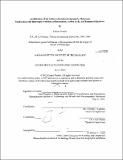Aridification of the Indian subcontinent during the Holocene : implications for landscape evolution, sedimentation, carbon cycle, and human civilizations
Author(s)
Ponton, Camilo
DownloadFull printable version (13.29Mb)
Other Contributors
Woods Hole Oceanographic Institution.
Advisor
Timothy I. Eglinton and Liviu Giosan.
Terms of use
Metadata
Show full item recordAbstract
The Indian monsoon affects the livelihood of over one billion people. Despite the importance of climate to society, knowledge of long-term monsoon variability is limited. This thesis provides Holocene records of monsoon variability, using sediment cores from river-dominated margins of the Bay of Bengal (off the Godavari River) and the Arabian Sea (off the Indus River). Carbon isotopes of terrestrial plant leaf waxes ([delta]¹³Cwax) preserved in sediment provide integrated and regionally extensive records of flora for both sites. For the Godavari River basin the ([delta]¹³Cwax record shows a gradual increase in aridity-adapted vegetation from ~4,000 until 1,700 years ago followed by the persistence of aridity-adapted plants to the present. The oxygen isotopic composition of planktonic foraminifera from this site indicates drought-prone conditions began as early as -3,000 years BP. The aridity record also allowed examination of relationships between hydroclimate and terrestrial carbon discharge to the ocean. Comparison of radiocarbon measurements of sedimentary plant waxes with planktonic foraminifera reveal increasing age offsets starting -4,000 yrs BP, suggesting that increased aridity slows carbon cycling and/or transport rates. At the second site, a seismic survey of the Indus River subaqueous delta describes the morphology and Holocene sedimentation of the Pakistani shelf and identified suitable coring locations for paleoclimate reconstructions. The ([delta]¹³Cwax record shows a stable arid climate over the dry regions of the Indus plain and a terrestrial biome dominated by C₄ vegetation for the last 6,000 years. As the climate became more arid ~4,000 years, sedentary agriculture took hold in central and south India while the urban Harappan civilization collapsed in the already arid Indus basin. This thesis integrates marine and continental records to create regionally extensive paleoenvironmental reconstructions that have implications for landscape evolution, sedimentation, the terrestrial organic carbon cycle, and prehistoric human civilizations in the Indian subcontinent.
Description
Thesis (Ph. D.)--Joint Program in Oceanography/Applied Ocean Science and Engineering (Massachusetts Institute of Technology, Dept. of Earth, Atmospheric, and Planetary Sciences; and the Woods Hole Oceanographic Institution), 2012. Cataloged from PDF version of thesis. Includes bibliographical references.
Date issued
2012Department
Joint Program in Oceanography/Applied Ocean Science and Engineering; Woods Hole Oceanographic Institution; Massachusetts Institute of Technology. Department of Earth, Atmospheric, and Planetary SciencesPublisher
Massachusetts Institute of Technology
Keywords
Joint Program in Oceanography/Applied Ocean Science and Engineering., Earth, Atmospheric, and Planetary Sciences., Woods Hole Oceanographic Institution.